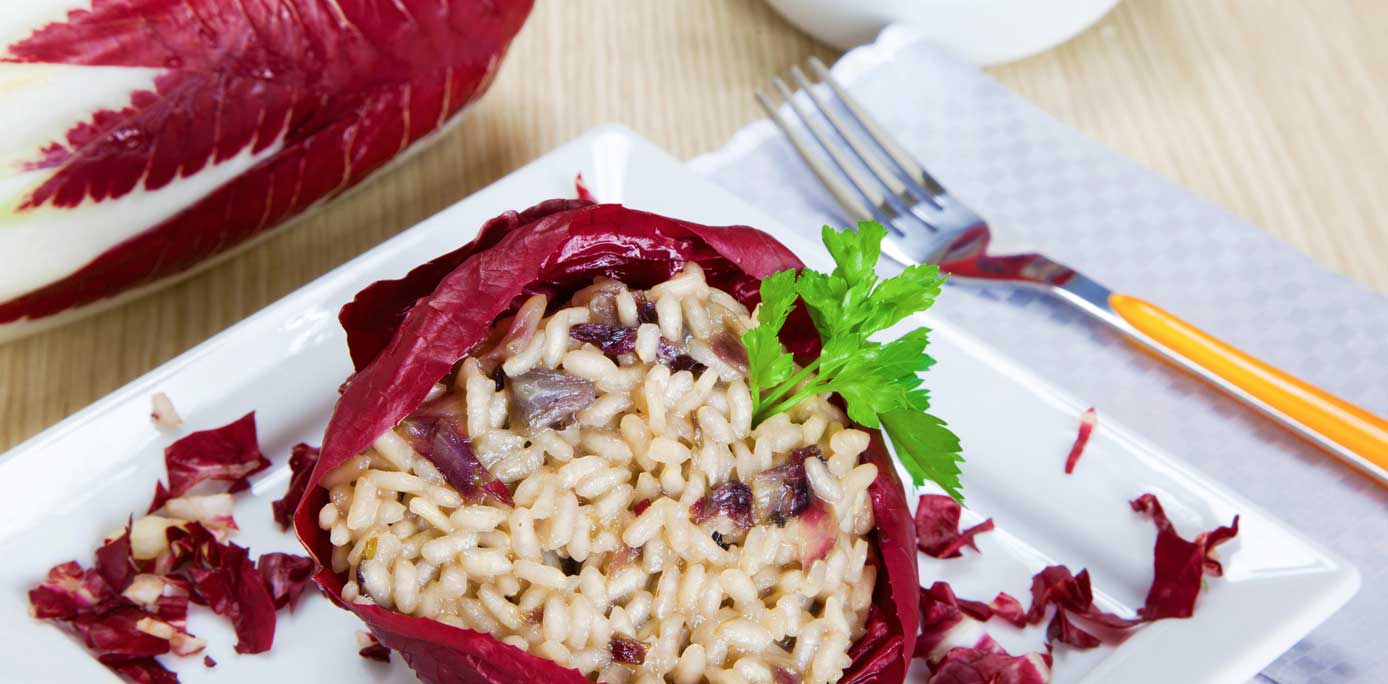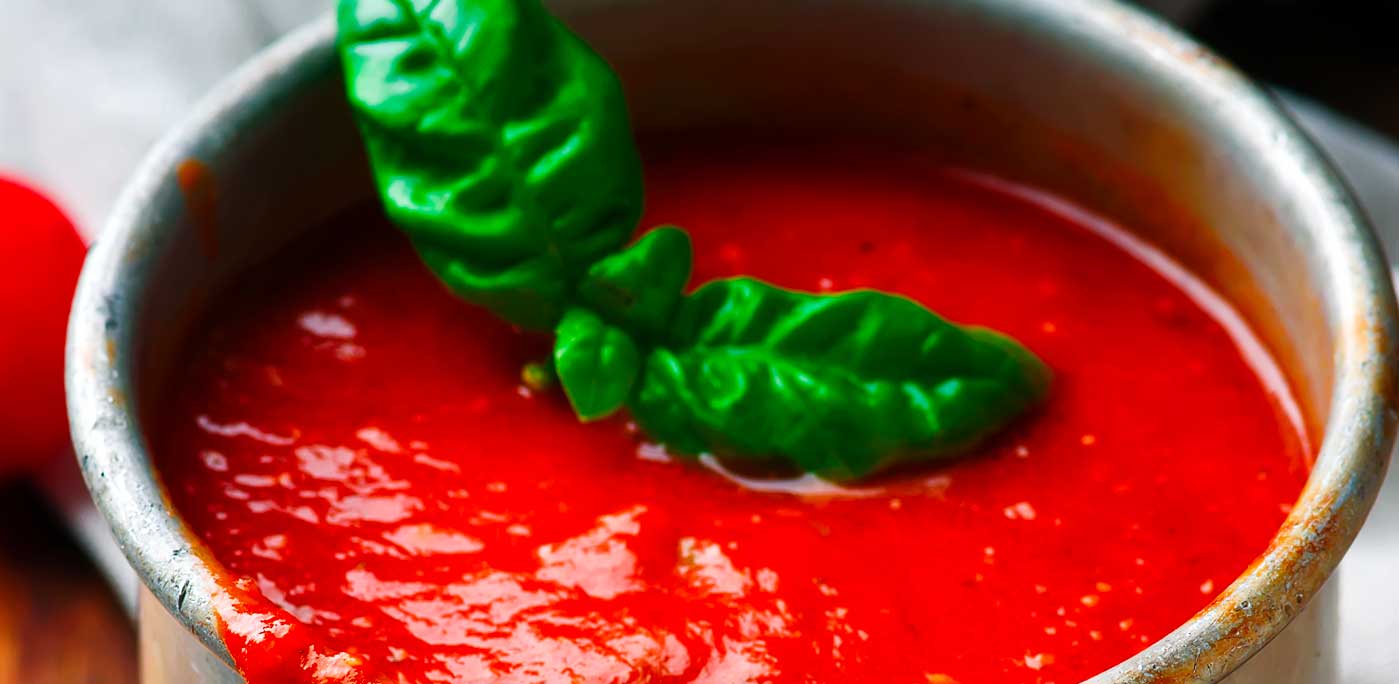In our market in Montalcino last week, the Winter array of radicchios were on full display. Tucked in alongside the Winter squashes and bright piles of oranges, were piles of radicchio with long tender leaves that curl upon themselves, and others plump and round that looked like small cabbages. Radicchio, part of the chicory family, is much more common in Italy than in the US and its numerous varieties are typically named after the region in which they are grown. Here in the US, we most easily find the plump round Chioggia variety – sometimes tucked away on the top shelf of the market, hidden away except for those of us who truly seek it out. Many shy away from this delightful Winter vegetable because of its slightly bitter taste, however, for those of us who appreciate its subtle bitterness, radicchio makes for a wonderful addition to the Winter menu beyond its normal place mixed in with lettuce in a salad. Radicchio has even been credited with stimulating the appetite and acting as a tonic for your liver – what’s not to love about this delightful Winter treat?
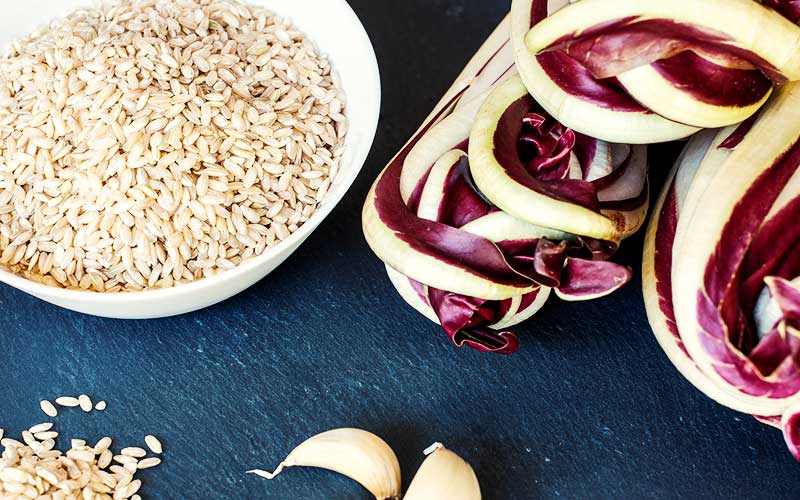
This risotto takes up a wonderful pink hue thanks to radicchio and pomegranate © Andrea Migliarini | Dreamstime.com
Radicchio makes for a wonderful salad on its own – slivered and dressed with a bit of good quality olive oil and vinegar. Radicchio’s bitter, chewy note adds a wonderful flavor to dishes especially when paired with veggies that have a bit of sweetness such as fennel or butternut squash, or with Winter fruits such as pears or apples. The combination of bitter and sweet mellows into a wonderful explosion of flavor. Although radicchio can now be found all year, it is best when in its true season – beginning around November – when it is most flavorful.
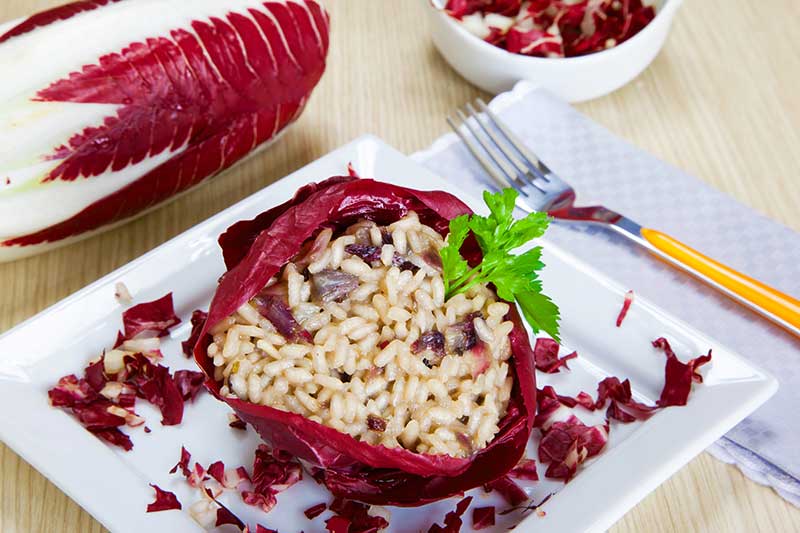
Try it with a pear sauce on top © Logichecreative | Dreamstime.com
Here I have used radicchio to make a simple risotto that takes on a pretty pink hue with the combination of red wine. The dish makes for an elegant presentation when topped with a few slivers of radicchio and pomegranate seeds. I love to drizzle it with a note of sweetness, such as a pear sauce or pomegranate reduction (I have included both in the recipe below).
This simple risotto pairs beautifully with a crisp white wine or fruity red…a simple meal to enjoy during cold Winter evenings!
Buon appetito!
Michele
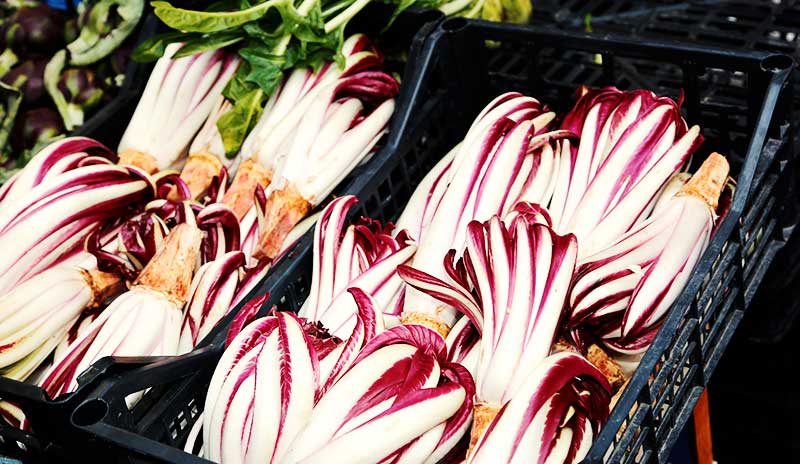
Seasonal radicchio is tastier © Fedecandoniphoto | Dreamstime.com
Risotto al Radicchio
Serves 6
Ingredients:
• About 4 cups low-sodium vegetable broth
• 1 tablespoon extra virgin olive oil
• 2 medium (or 1 large) shallots, chopped
• 1 1/2 cups Arborio rice
• 1 cup dry red wine
• A few sprigs thyme leaves
• 1 small head radicchio, halved, thinly sliced crosswise
• ½ cup grated Parmesan or Romano
• 2 tablespoons unsalted butter
• Kosher salt
• Freshly ground black pepper
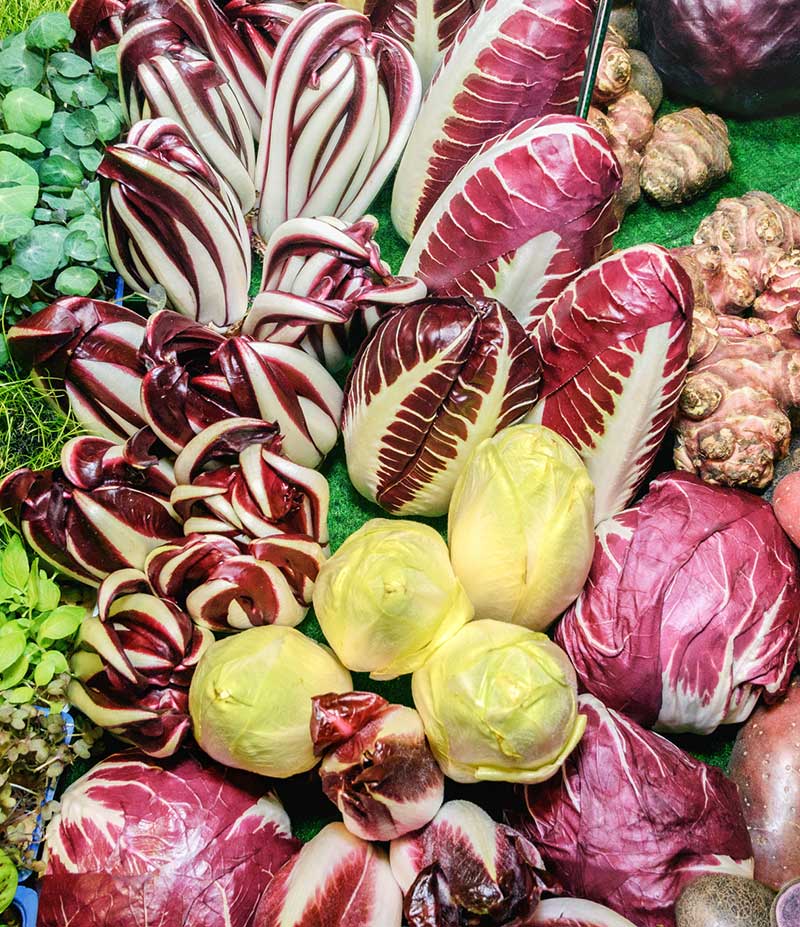
Radicchio makes for a wonderful salad on its own – slivered and dressed with a bit of good quality olive oil and vinegar
Directions:
Make the risotto:
In a small saucepan, bring the broth to a simmer over medium heat. Reduce the heat to low, cover and keep warm until ready to use for the risotto. In a pan large enough to hold the risotto, heat the olive oil over medium low heat. Add in the shallots and cook until translucent and soft, 5 minutes. Add in the rice and stir to coat it. Cook until slightly toasted, about 3 minutes. Add in the wine and thyme. Cook until the liquid is absorbed, stirring often.
Begin adding the broth, one ladle at a time, stirring until the broth is almost all absorbed before adding the next (if I run low on broth, I typically just add water to the it to dilute it a bit). About 2/3 of the way through the broth, toss in the sliced radicchio and stir to combine. Continue adding broth until the rice is al dente or tender but still firm to the bite. This should take about 20 minutes.
Remove the risotto from the heat. Stir in the cheese and the butter until incorporated. Taste and season with additional salt and pepper, if necessary. Top with some fresh torn radicchio and pomegranate seeds. Drizzle with pear sauce, if using, and serve immediately.
Optional drizzles for the top:
Pear sauce: peel and rough chop a few pears. Heat a few tablespoons of olive oil in a pan over medium heat. Add the pears and a few cloves of diced garlic and sauté until the garlic is soft, about 1 minute. Add in about a cup of vegetable broth and simmer until the pears are soft. Remove from heat and allow to cool. Purée the mixture. Season with salt and pepper. Keep warm and drizzle over the risotto.
Pomegranate reduction: heat a few cups of pomegranate juice in a pan over medium heat. Simmer until thickened and reduced to about ½ cup, 20 to 30 minutes depending on size of pan.
Nel nostro mercato di Montalcino, la scorsa settimana, l’assortimento invernale di radicchio era in piena esposizione. Accanto alle zucche invernali e ai luminosi cumuli di arance, c’erano mucchi di radicchio con lunghe e tenere foglie arricciate su se stesse, e altri così paffuti e rotondi che sembravano piccoli cavoli. Il radicchio, che fa parte della famiglia delle cicorie, è molto più diffuso in Italia che non negli Stati Uniti e le sue numerose varietà prendono il nome dalla regione in cui sono coltivate. Qui, negli Stati Uniti, troviamo più facilmente la varietà Chioggia, a volte infilata sul ripiano superiore del mercato, nascosta, tranne a quanti la cercano veramente. Molti diffidano di questo delizioso ortaggio invernale a causa del sapore leggermente amarognolo, ma, per noi che ne apprezziamo il delicato gusto amaro, il radicchio rappresenta una splendida aggiunta al menù invernale oltre al suo consumo normale, mescolato alla lattuga in insalata. Al radicchio è stato attribuito anche il merito di stimolare l’appetito e di agire come tonico per il fegato: cosa non possiamo non amare di questa deliziosa pietanza invernale?
Il radicchio da solo è un’insalata meravigliosa, arricchito e condito con un po’ di olio d’oliva e aceto di buona qualità. La nota amara e masticabile del radicchio aggiunge un sapore meraviglioso ai piatti, soprattutto se abbinato a verdure che hanno un po’ di dolcezza come il finocchio o la zucca violina, o a frutti d’inverno come pere o mele. La combinazione di amaro e dolce si fondono in una meravigliosa esplosione di sapore. Anche se il radicchio si può trovare tutto l’anno, è migliore quando è di stagione – più o meno a partire da novembre – quando è più saporito.
Qui ho usato il radicchio per fare un semplice risotto che assume un bel colore rosa con l’abbinamento del vino rosso. Il piatto si presta ad una presentazione elegante se condito con qualche foglia di radicchio e chicchi di melograno. Mi piace bagnarlo con una nota di dolcezza, come la salsa di pere o la riduzione di melograno (li ho inclusi entrambi nella ricetta sottostante).
Questo semplice risotto si abbina magnificamente a un vino bianco frizzante o a un rosso fruttato….un pasto semplice da gustare nelle fredde serate invernali!
Buon appetito!
Michele
Risotto al Radicchio
Per sei persone
Ingredienti:
•Circa 4 tazze di brodo vegetale a basso contenuto di sodio
•1 cucchiaio di olio extra vergine di oliva
•2 scalogni medi (o 1 grande), tritati
•1 tazza e 1/2 di riso Arborio
•1 tazza di vino rosso secco
•Qualche rametto di foglie di timo
•1 testa piccola di radicchio, a metà, tagliata trasversalmente in fette sottili
•½ tazza di Parmigiano grattugiato o Romano
•2 cucchiai di burro non salato
•Sale kosher
•Pepe nero appena macinato
Istruzioni:
Fare il risotto:
In una piccola casseruola, portare il brodo a bollire a fuoco medio. Abbassare il fuoco, coprire e tenere in caldo fino a quando non è pronto per l’uso nel risotto. In una padella abbastanza grande da contenere il risotto, scaldare l’olio d’oliva a fuoco medio-basso. Aggiungere gli scalogni e fare cuocere fino a quando saranno traslucidi e morbidi, 5 minuti. Aggiungere il riso e mescolare per coprirlo. Cuocere fino ad una leggera tostatura, circa 3 minuti. Aggiungere vino e timo. Cuocere fino a quando il liquido viene assorbito, mescolando spesso.
Iniziare ad aggiungere il brodo, un mestolo alla volta, mescolando fino a quando il brodo sarà quasi tutto assorbito prima di aggiungere il mestolo successivo (se il brodo finisce, si aggiunge in genere acqua per diluirlo un po’). A circa 2/3 della cottura con il brodo, mettere il radicchio a fette e mescolare per amalgamare. Continuare ad aggiungere il brodo fino a quando il riso è al dente o tenero ma ancora duro sotto i denti. Questo dovrebbe richiedere circa 20 minuti.
Togliere il risotto dal fuoco. Mescolare formaggio e burro fino ad incorporare. Assaggiare e condire con altro sale e pepe, se necessario. Coprire con del radicchio appena tagliato e semi di melograno. Condire con la salsa di pere, se la usate, e servire immediatamente.
Condimenti opzionali per la parte superiore:
Salsa di pere: sbucciare e tritare grossolanamente alcune pere. Scaldare qualche cucchiaio d’olio d’oliva in una padella a fuoco medio. Aggiungere le pere e qualche spicchio d’aglio tagliato a dadini e soffriggere fino a quando l’aglio è morbido, circa 1 minuto. Aggiungere circa una tazza di brodo vegetale e far sobbollire fino a quando le pere saranno morbide. Togliere dal fuoco e lasciare raffreddare. Rendere il composto a una purè. Condire con sale e pepe. Mantenere in caldo e versare sul risotto.
Riduzione di melograno: scaldare alcune tazze di succo di melograno in una padella a fuoco medio. Cuocere a fuoco lento fino a quando non si sarà addensato e ridotto a circa ½ tazza, da 20 a 30 minuti a seconda delle dimensioni della padella.




